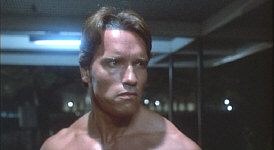 Today’s depressing realization: The Terminator came out precisely half of my life ago. When it hit in 1984, I was a vital 17 years old, but now I’m a decrepit 34. And it ain’t getting any better from here; it’s not like that “life percentage” will reverse itself.
Today’s depressing realization: The Terminator came out precisely half of my life ago. When it hit in 1984, I was a vital 17 years old, but now I’m a decrepit 34. And it ain’t getting any better from here; it’s not like that “life percentage” will reverse itself.
But enough whining about my advancing age. Although I really liked Terminator when I saw it in my youth, I must say that I haven’t watched it many times since then. Blame that on the release of 1991’s sequel, Terminator 2: Judgment Day. The top-grossing film for that year, T2 set a new standard for action flicks. When a new laserdisc release of Terminator appeared not long after the theatrical run of T2, I eagerly grabbed it. I remembered that I liked the first film, and my enjoyment of T2 seemed to indicate that I’d still care for it.
Unfortunately, T2 spoiled me for the older, cruder film. After the more high-tech and visceral thrills of the sequel, the original seemed a bit staid and cheesy. To be sure, I still liked the movie, but I found it to be less exciting and compelling than I remembered and expected.
Some might argue that I favor T2 mainly because of its bigger budget, and they’d largely be correct. However, I’m not taking a simple “bigger is better” stance. In many cases, lower-budget movies are superior to more extravagant affairs because they force the filmmakers to become more creative and resourceful. Crews for big money flicks don’t have to rely on such tactics, so the results can be bloated and flat.
However, I don’t feel that’s the case with the films of James Cameron. He’s worked with some huge budgets, but he hasn’t succumbed to any of the usual temptations. More so than probably any other filmmaker today, Cameron puts the money on the screen; I think his movies are clearly better for their extra expenditures.
 To a certain degree, the biggest difference between Terminator and T2 comes down to production values. T2 offers a much better realized world that communicates its elements with greater clarity and realism. For Terminator, Cameron and crew did wonderfully considering their budgetary restrictions, but the cheapness of the film remains evident. That isn’t the case with T2, which had a ton of money behind it.
To a certain degree, the biggest difference between Terminator and T2 comes down to production values. T2 offers a much better realized world that communicates its elements with greater clarity and realism. For Terminator, Cameron and crew did wonderfully considering their budgetary restrictions, but the cheapness of the film remains evident. That isn’t the case with T2, which had a ton of money behind it.
I also think that Cameron clearly was a stronger, more confident filmmaker by the time of T2. Between the two films, he made two excellent flicks: 1986’s Aliens and 1989’s The Abyss. Aliens represented a quantum leap over Terminator, as it offered a smoother and more compelling vision. The Abyss wasn’t better than Aliens - heck, I don’t think any movie’s better than Aliens - but it created a solid flick nonetheless.
While I doubt Cameron could have gone on to such heights without his experiences on Terminator, I think that virtually all of his subsequent films top it and it looks a bit dated today. Terminator remains an entertaining and seminal work, but it doesn’t match up with Cameron’s later works.
Terminator deals with time travel at its start. Two future warriors return to 1984. One - a cyborg called a Terminator (Arnold Schwarzenegger) - has been sent to kill the mother of a man who will become a rebel leader. That woman - Sarah Connor (Linda Hamilton) - hasn’t had her son or even met his father yet, so the machine leaders hope to nip that prospect in the bud; no Sarah, no John, no rebellion, or at least that’s what the future computers hope.
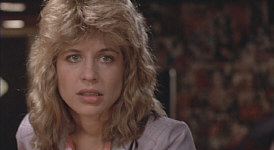 To protect Sarah, the human resistance sends Kyle Reese (Michael Biehn). Throughout the early parts of the film, both Kyle and the Terminator track Sarah, and once the cyborg makes her, the chase is on. Essentially the rest of the film follows Sarah and Kyle as they run from the Terminator and try to find a way to get rid of him, something that’s no easy task with the then-current state of weaponry.
To protect Sarah, the human resistance sends Kyle Reese (Michael Biehn). Throughout the early parts of the film, both Kyle and the Terminator track Sarah, and once the cyborg makes her, the chase is on. Essentially the rest of the film follows Sarah and Kyle as they run from the Terminator and try to find a way to get rid of him, something that’s no easy task with the then-current state of weaponry.
When I first saw previews for The Terminator, I thought it’d be a cheesy genre flick that’d come and go quickly. I was quite surprised to see the high regard with which both critics and audiences regarded it. While Terminator shared the low budgets and mercenary tone of that kind of movie, it offered a much more engaging and innovative experience than anyone could have expected.
It still does so, though I really feel that it seems somewhat bland compared to later Cameron offerings. Without a doubt, Terminator was a much more original and seminal program than was T2; in many ways, one could argue the latter simply remade the older movie. While I don’t think that Terminator is a museum piece, I will argue that it comes across somewhat poorly in comparison with its successors.
At 107 minutes, Terminator is the shortest movie made by Cameron with the exception of his initial directorial effort, 1981’s Piranha II: The Spawning. The length differences aren’t minor; the theatrical cuts of both Aliens and T2 ran exactly 30 minutes longer than Terminator, while both the original release of The Abyss and 1994’s True Lies ran stayed in the same neighborhood; they entered the 140-minute-plus realm, but they weren’t much longer than the other two. Then there’s Cameron’s biggest success, 1997’s Titanic, with its 193-minute running time.
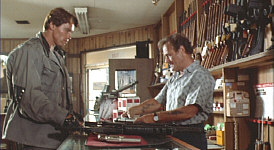 Some feel that the shorter length means that Terminator offers a tighter experience than the later, longer flicks, with a particular emphasis on the differences between it and its sequel. I disagree, mainly because I think T2 is a richer, better-realized work. Despite the increase in length, I don’t find any padding in T2, while Terminator includes a few segments that feel unnecessary.
Some feel that the shorter length means that Terminator offers a tighter experience than the later, longer flicks, with a particular emphasis on the differences between it and its sequel. I disagree, mainly because I think T2 is a richer, better-realized work. Despite the increase in length, I don’t find any padding in T2, while Terminator includes a few segments that feel unnecessary.
Terminator easily comes across as the most dated of Cameron’s films. No other work of his seems quite as heavily anchored in its era; those mid-Eighties fashions haven’t aged well. Perhaps T2 will look just as silly in 2008, but I doubt it.
Objectively, The Terminator really is a pretty good movie. It certainly was an influential work that helped create a whole new genre. However, despite its originality, the film has been surpassed by later examples from the field. 17 years after its original release, The Terminator remains a fairly solid action flick, but it’s not one that I think stands among the best in its realm.
The DVD:
The Terminator appears in an aspect ratio of approximately 1.85:1 on this double-sided DVD; the image has been enhanced for 16X9 televisions. From what I understand, the movie side is a dual-layered disc, while the flipside - which includes all of the supplements - is a single-layered disc. This confuses my little brain, but it doesn’t really matter in the end.
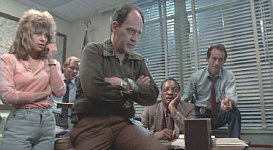 Although The Terminator occasionally showed its age and budget limitations, as a whole I thought it provided a fine visual experience. Sharpness looked consistently fine throughout the film. At all times I felt the picture appeared stable and distinct, with no signs of softness or fuzziness. Moiré effects and jagged edges caused no concerns, and I detected no examples of edge enhancement.
Although The Terminator occasionally showed its age and budget limitations, as a whole I thought it provided a fine visual experience. Sharpness looked consistently fine throughout the film. At all times I felt the picture appeared stable and distinct, with no signs of softness or fuzziness. Moiré effects and jagged edges caused no concerns, and I detected no examples of edge enhancement.
Terminator showed it low-budget origins through its colors and black levels. While these seemed fairly good much of the time, they betrayed the cheap film stock on occasion. Most colors looked nicely rich and lively, and they remained clear and accurate through much of the movie. The main problems related to hues arose during some of the club sequences. Those used colored lighting that could appear a bit too runny at times.
Black levels also came across as nicely deep and dark for much of the movie. Shadow detail usually looked clean and neatly visible. Some interiors appeared to be somewhat murky and thick, however, and they didn’t always present the clearest image. Still, they mainly appeared to be appropriately opaque but not excessively thick.
Print flaws were a minor concern. Some grain and speckles occasionally cropped up, and I also saw a little additional debris at times. Nonetheless, the print usually appeared surprisingly clean and fresh. Ultimately the image showed a moderate number of concerns, but I thought it was a generally satisfying picture, especially given the age and cost of the material; I believe this is the best The Terminator has looked in years.
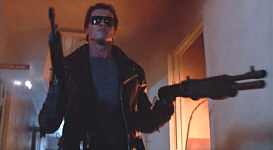 On the other hand, the Dolby Digital 5.1 soundtrack offered the best sound ever heard for The Terminator. The mix came from the original monaural track, which also appears on the DVD. I’m happy the mono version also came on the disc, because it’s important to retain the original audio. However, I’ll never listen to it, for the newly created 5.1 mix made it seem totally superfluous.
On the other hand, the Dolby Digital 5.1 soundtrack offered the best sound ever heard for The Terminator. The mix came from the original monaural track, which also appears on the DVD. I’m happy the mono version also came on the disc, because it’s important to retain the original audio. However, I’ll never listen to it, for the newly created 5.1 mix made it seem totally superfluous.
The soundfield really opened up the track as it offered a broad and engaging spectrum. At times I felt the audio seemed to be somewhat “speaker-specific”, as stems popped up rather strictly in one channel or another. Sounds also didn’t blend together in an especially seamless manner; elements tended to mildly jump from one area to another when they panned.
Nonetheless, these criticisms seem a little nitpicky given the origins of the material. For a track compiled from a mono mix, Terminator offered a terrific soundfield. All five channels provided a rather active experience, and they added a solid sense of environment. The score showed good stereo separation in the front, and the effects often came from all around me. The Future War sequences seemed to be especially effective, as they showed good split-surround usage and some fine breadth.
Audio quality betrayed the film’s age at times, but I didn’t think it put a tremendously negative spin on the action. Dialogue usually sounded reasonably clear and natural, though speech appeared somewhat thin and reedy at times and some louder lines displayed moderate edginess. Intelligibility was never a concern, however. Some distortion also accompanied a few effects, but they usually seemed to be clear and accurate, and they offered some positive depth. The score appeared nicely vibrant and bright, and it demonstrated good dynamics. Ultimately, The Terminator was a fine soundtrack that made the aging material come to life.
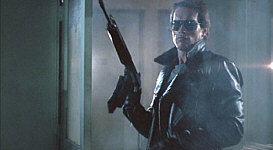 While the original DVD release of The Terminator included virtually no extras, the new MGM version adds on a nice roster of supplements. Most of these involve video programs, starting with two separate documentaries. The Terminator: A Retrospective offers interviews with writer/director James Cameron and actor Arnold Schwarzenegger. All of these clips come from older sessions. There are shots of both men together and separately that were shot in 1992, and we also find clips of Cameron with Don Shay from sessions contemporary with Aliens sessions in 1986; these will look familiar to owners of that DVD.
While the original DVD release of The Terminator included virtually no extras, the new MGM version adds on a nice roster of supplements. Most of these involve video programs, starting with two separate documentaries. The Terminator: A Retrospective offers interviews with writer/director James Cameron and actor Arnold Schwarzenegger. All of these clips come from older sessions. There are shots of both men together and separately that were shot in 1992, and we also find clips of Cameron with Don Shay from sessions contemporary with Aliens sessions in 1986; these will look familiar to owners of that DVD.
The absence of any new comments in the “Retrospective” seems unfortunate, but the 18-minute and five-second program offers a fair amount of good information nonetheless. The Shay sessions have the benefit of their era; since they took place only two years after the release of Terminator, there wasn’t much time for attitudes to change or memories to falter. That said, the bits with Schwarzenegger and Cameron together were the most interesting, since we got to see them play off of each other. Overall, the “Retrospective” adds a nice look at the film, though not an extensive one.
Better in that regard was the second documentary, a new one called Other Voices. This 60-minute and 15-second program comes almost wholly from new interviews with a mix of participants. We hear from Cameron, producer Gale Ann Hurd, actor Michael Biehn, collaborator Bill Wisher, makeup effects technician Stan Winston, editor Mark Goldblatt, composer Brad Fiedel, Fantasy II VFX Supervisor Gene Warren - and his son Chris briefly toward the end - plus visual effects pyrotechnician Joe Viskocil. In addition, we see a few more clips from the 1992 Cameron/Schwarzenegger session as well as 1991 clips with Schwarzenegger and actress Linda Hamilton, both of whom were filmed separately on the set of T2.
 Produced by Van Ling, “Other Voices” creates a very fine look at Terminator as a whole. The entire project is discussed in detail, from its origins through its casting through the nuts and bolts of the daily production. Not surprisingly, special effects receive a moderate emphasis, but this isn’t a technical program overall, and it doesn’t get weighed down with dry material. Instead, it goes over a mix of notes as it maintains a brisk and entertaining pace. The absence of new material from Hamilton and Schwarzenegger seems disappointing, but the program offers a positive experience nonetheless.
Produced by Van Ling, “Other Voices” creates a very fine look at Terminator as a whole. The entire project is discussed in detail, from its origins through its casting through the nuts and bolts of the daily production. Not surprisingly, special effects receive a moderate emphasis, but this isn’t a technical program overall, and it doesn’t get weighed down with dry material. Instead, it goes over a mix of notes as it maintains a brisk and entertaining pace. The absence of new material from Hamilton and Schwarzenegger seems disappointing, but the program offers a positive experience nonetheless.
Next we get a collection of Terminated Scenes. Normally known as “deleted scenes”, we find seven unused clips, all of which add up to nine minutes and 50 seconds of material. Many of these are very brief cuts, such as a shot of the Terminator as he leaves the scene of his first Sarah Connor murder. However, a few are more substantial, such as a piece that shows additional character interaction between Sarah and Reese. These are interesting segments, though I agree that most of them deserved to be cut; I would have kept a short snippet in which Paul Winfield’s character departs the movie, but otherwise these bits were unnecessary.
All of the “Terminated Scenes” can be watched with their standard audio or with commentary from Cameron. For the latter track, it appears that Cameron didn’t actually sit and watch the clips in the normal fashion. Instead, it sounds like he was questioned about them and the results appeared on the DVD. This works fine, as Cameron covers the deleted shots well. He goes over some background information and generally relates why they were removed. The commentary adds some good details and helps make the section more effective.
 One very interesting extra is Cameron’s Original Treatment for The Terminator. From 1982, this text document shows his initial story plan for the film. Interestingly, he stayed with this first draft pretty closely. To be sure, a number of alterations occur, but it includes more similarities than discrepancies, especially when one factors in the deleted scenes; some material seen in the treatment but not the final film was shot but cut. The “Original Treatment” offers a compelling historical document.
One very interesting extra is Cameron’s Original Treatment for The Terminator. From 1982, this text document shows his initial story plan for the film. Interestingly, he stayed with this first draft pretty closely. To be sure, a number of alterations occur, but it includes more similarities than discrepancies, especially when one factors in the deleted scenes; some material seen in the treatment but not the final film was shot but cut. The “Original Treatment” offers a compelling historical document.
The Still Galleries add five different subdomains of shots. We get “James Cameron Artwork”, with 138 sketches and paintings; “Production Photos” with 459 movie stills and shots from the set; “Stan Winston Effects” with 139 images of those various elements; “Fantasy II Visual Effects” with 217 frames of their work; and “Publicity Materials” with 82 promotional photos, posters and other ad materials. All of these were fairly good, though the “Production Photos” probably brought the least to the table. The “Publicity Materials” were the best of the bunch; they’re worth a look if just to see the dorky headshot of Schwarzenegger in a tux.
In the Trailers and TV Spots area, we get a teaser, the standard US trailer, a foreign promo, plus two television ads. Inside the DVD’s case, we find a very good booklet. This eight-page piece provides some nice notes about the film.
Although all of these extras appear on Side Two, the movie platter includes some hidden extras in the form of Easter Eggs. Skim around the different menus and click on the little boxes found on the sides of the screens. There you’ll find lots of interview snippets that would have fit well within the “Other Voices” documentary. You’ll have to click on the same box multiple times to get them all, and you’ll undoubtedly see the same snippets more than once before you see each clip, but it’s worth it, as these are some good bits of information. Oh, and there’s also a text piece called “Chrono Surfing: A Brief History of Time Travel” by Randall Frakes buried in one of the boxes; otherwise all of the components appear to be video-based.
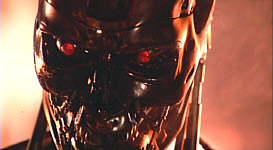 DVD-ROM users will be able to access a few additional pieces on Side One. There we can check out the “Original Treatment” also found in the supplemental area as well as the “1983 4th Draft” and the “Final Shooting Script”. The latter can be viewed alongside the movie itself, while the other two are simple text affairs.
DVD-ROM users will be able to access a few additional pieces on Side One. There we can check out the “Original Treatment” also found in the supplemental area as well as the “1983 4th Draft” and the “Final Shooting Script”. The latter can be viewed alongside the movie itself, while the other two are simple text affairs.
While The Terminator doesn’t match up tremendously well with director James Cameron’s later films, it remains an influential, seminal and enjoyable movie. What it lacks in polish it makes up for in heart and energy to a degree. I admit I prefer its sequel, but The Terminator still has a lot going for it, as does this terrific DVD. The picture and sound show their age at times, but they seem to be as good - or better - than I could have expected, and the mix of supplements adds a lot to the package. I can’t say that The Terminator is one of my favorite action films, but it’s a good piece and this fine DVD makes it even more appealing.